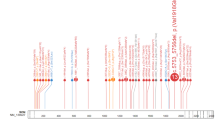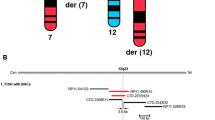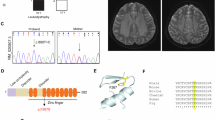Abstract
Primrose syndrome is characterized by variable intellectual deficiency, behavior disorders, facial features with macrocephaly, and a progressive phenotype with hearing loss and ectopic calcifications, distal muscle wasting, and contractures. In 2014, ZBTB20 variants were identified as responsible for this syndrome. Indeed, ZBTB20 plays an important role in cognition, memory, learning processes, and has a transcription repressive effect on numerous genes. A more severe phenotype was discussed in patients with missense single nucleotide variants than in those with large deletions. Here, we report on the clinical and molecular results of 14 patients: 6 carrying ZBTB20 missense SNVs, 1 carrying an early truncating indel, and 7 carrying 3q13.31 deletions, recruited through the AnDDI-Rares network. We compared their phenotypes and reviewed the data of the literature, in order to establish more powerful phenotype–genotype correlations. All 57 patients presented mild-to-severe ID and/or a psychomotor delay. Facial features were similar with macrocephaly, prominent forehead, downslanting palpebral fissures, ptosis, and large ears. Hearing loss was far more frequent in patients with missense SNVs (p = 0.002), ectopic calcification, progressive muscular wasting, and contractures were observed only in patients with missense SNVs (p nonsignificant). Corpus callosum dysgenesis (p = 0.00004), hypothyroidism (p = 0.047), and diabetes were also more frequent in this group. However, the median age was 9.4 years in patients with deletions and truncating variant compared with 15.1 years in those with missense SNVs. Longer follow-up will be necessary to determine whether the phenotype of patients with deletions is also progressive.
This is a preview of subscription content, access via your institution
Access options
Subscribe to this journal
Receive 12 print issues and online access
$259.00 per year
only $21.58 per issue
Buy this article
- Purchase on SpringerLink
- Instant access to full article PDF
Prices may be subject to local taxes which are calculated during checkout




Similar content being viewed by others
References
Flore LA, Milunsky JM. Updates in the genetic evaluation of the child with global developmental delay or intellectual disability. Semin Pediatr Neurol. 2012;19:173–80.
Cooper GM, Coe BP, Girirajan S, Rosenfeld JA, Vu TH, Baker C, et al. A copy number variation morbidity map of developmental delay. Nat Genet. 2015;43:838–46.
Retterer K, Juusola J, Cho MT, Vitazka P, Millan F, Gibellini F, et al. Clinical application of whole-exome sequencing across clinical indications. Genet Med. 2016;18:696–704.
Chong JX, Buckingham KJ, Jhangiani SN, Boehm C, Sobreira N, Smith JD, et al. The genetic basis of mendelian phenotypes: discoveries, challenges and opportunities. Am J Hum Genet. 2015;97:199–215.
Battisti C, Dotti MT, Cerase A, Rufa A, Sicurelli F, Scarpini C, et al. The Primrose syndrome with progressive neurological involvement and cerebral calcification. J Neurol. 2002;249:1466–8.
Dalal P, Leslie ND, Lindor NM, Gilbert DL, Espay AJ. Motor tics, stereotypies, and self-flagellation in primrose syndrome. Neurology. 2010;75:284–6.
Cordeddu V, Redeker B, Stellacci E, Jongejan A, Fragale A, Bradley TE, et al. Mutations in ZBTB20 cause Primrose syndrome. Nat Genet. 2014;46:815–7.
Mattioli F, Piton A, Gérard B, Superti-Furga A, Mandel JL, Unger S. Novel de novo mutations in ZBTB20 in Primrose syndrome with congenital hypothyroidism. Am J Med Genet A. 2016;170:1626–9.
Molin AM, Andrieux J, Koolen DA, Malan V, Carella M, Colleaux L, et al. A novel microdeletion syndrome at 3q13.31 characterised by developmental delay, postnatal overgrowth, hypoplastic male genitals, and characteristic facial features. J Med Genet. 2012;49:104–9.
Redin C, Gérard B, Lauer J, Herenger Y, Muller J, Quartier A, et al. Efficient strategy for the molecular diagnosis of intellectual disability using targeted high-throughput sequencing. J Med Genet. 2014;51:724–36.
Geoffroy V, Pizot C, Redin C, Piton A, Vasli N, Stoetzel C, et al. VaRank: a simple and powerful tool for ranking genetic variants. Peer J. 2015;3:e796.
Thevenon J, Duffourd Y, Masurel-Paulet A, Lefebvre M, Feillet F, El Chehadeh-Djebbar S, et al. Diagnostic odyssey in severe neurodevelopmental disorders: toward clinical whole-exome sequencing as a first-line diagnostic test. Clin Genet. 2016;589:700–7.
Alby C, Boutaud L, Bessières B, Serre V, Rio M, Cormier-Daire V, et al. Novel de novo ZBTB20 mutations in three cases with Primrose syndrome and constant corpus callosum anomalies. Am J Med Genet Part A. 2018;176A:1091–8.
Casertano A, Fontana P, Hennekam RC, Tartaglia M, Genesio R, Dieber TB, et al. Alterations in metabolic patterns have a key role in diagnosis and progression of Primrose syndrome. Am J Med Genet A. 2017;173:1896–902.
Koido K, Traks T, Balõtšev R, Eller T, Must A, Koks S, et al. Associations between LSAMP gene polymorphisms and major depressive disorder and panic disorder. Transl Psychiatry. 2012;2:e152.
Crocq MA, Mant R, Asherson P, Williams J, Hode Y, Mayerova A, et al. Association between schizophrenia and homozygosity at the dopamine D3 receptor gene. J Med Genet. 1992;29:858–60.
Lucotte G, Lagarde JP, Funalot B, Sokoloff P. Linkage with the Ser9Gly DRD3 polymorphism in essential tremor families. Clin Genet. 2006;69:437–40.
Lowther C, Costain G, Melvin R, Stavropoulos DJ, Lionel AC, Marshall CR, et al. Adult expression of a 3q13.31 microdeletion. Mol Cytogenet. 2014;7:23.
Mathijssen IB, van Hasselt-van der Velde J, Hennekam RC. Testicular cancer in a patient with Primrose syndrome. Eur J Med Genet. 2006;49:127–33.
Vuillaume ML, Delrue MA, Naudion S, Toutain J, Fergelot P, Arveiler B, et al. Expanding the clinical phenotype at the 3q13.31 locus with a new case of microdeletion and first characterization of the reciprocal duplication. Mol Genet Metab. 2013;110:90–7.
Carvalho DR, Speck-Martins CE. Additional features of unique Primrose syndrome phenotype. Am J Med Genet Part A. 2011;155:1379–83.
Posmyk R, Leśniewicz R, Chorąży M, Wołczyński S. New case of Primrose syndrome with mild intellectual disability. Am J Med Genet A. 2011;155A:2838–40.
Quintela I, Gomez-Guerrero L, Fernandez-Prieto M, Resches M, Barros F, Carracedo A, et al. Female patient with autistic disorder, intellectual disability, and co-morbid anxiety disorder: expanding the phenotype associated with the recurrent 3q13.2–q13.31 microdeletion. Am J Med Genet Part A. 2015;167A:3121–9.
Stellacci E, Steindl K, Joset P, Mercurio L, Anselmi M, Cecchetti S, et al. Clinical and functional characterization of two novel ZBTB20 mutations causing Primrose syndrome. Hum Mutat. 2018;39:959–64.
Grímsdóttir S, Hove HB, Kreiborg S, Ek J, Johansen A, Darvann TA, et al. Novel de novo mutation in ZBTB20 in Primrose syndrome in boy with short stature. Clin Dysmorphol. 2019;28:41–5.
Cleaver R, Berg J, Craft E, Foster A, Gibbons RJ, Hobson E, et al. Refining the Primrose syndrome phenotype: a study of five patients with ZBTB20 de novo variants and a review of the literature. Am J Med Genet A. 2019;179(3):344–9.
Acknowledgements
We wish to thank the patients and their families involved in the study, and the physicians who referred their patients to our center. We also thank the University of Burgundy Centre de Calcul (CCuB) for technical support and management of the informatics platform. This work was supported by grants from Dijon University Hospital, the Regional Council of Burgundy Franche-Comté through the Plan d’Actions Régional pour l’Innovation (PARI 2016), and the European Union through the PO FEDER-FSE Bourgogne 2014/2020 programs and the FEDER 2016. This work was also partially funded by the French Ministry of Health (PHRC national 2008/2008-A00515-50) and the Regional Council of Burgundy/Dijon University hospital (PARI 2012). URLs DGV: http://dgv.tcag.ca/dgv/app/home. ClinVAR: https://www.ncbi.nlm.nih.gov/clinvar/. Decipher: https://decipher.sanger.ac.uk/. ExAC Browser: https://exac.broadinstitute.org, GnomAD: https://gnomad.broadinstitute.org. OMIM: https://www.omim.org. RefSeq: https://www.ncbi.nlm.nih.gov/refseq/. UCSC: https://genome.ucsc.edu.
Author information
Authors and Affiliations
Corresponding author
Ethics declarations
Conflict of interest
The authors declare that they have no conflict of interest.
Additional information
Publisher’s note Springer Nature remains neutral with regard to jurisdictional claims in published maps and institutional affiliations.
Supplementary information
Rights and permissions
About this article
Cite this article
Juven, A., Nambot, S., Piton, A. et al. Primrose syndrome: a phenotypic comparison of patients with a ZBTB20 missense variant versus a 3q13.31 microdeletion including ZBTB20. Eur J Hum Genet 28, 1044–1055 (2020). https://doi.org/10.1038/s41431-020-0582-3
Received:
Revised:
Accepted:
Published:
Issue date:
DOI: https://doi.org/10.1038/s41431-020-0582-3



